MGT520 Module 5: Strategic Management - Nestle vs. Fonterra Analysis
VerifiedAdded on 2022/08/12
|8
|1738
|17
Report
AI Summary
This report provides a comparative analysis of the vision and mission statements of Nestle and Fonterra, two major players in the dairy industry. The report begins by outlining the vision and mission statements of each company, highlighting Nestle's focus on providing 'Good Food, Good Life' and Fonterra's emphasis on environmental sustainability and community engagement. It then compares the two, pointing out Nestle's dedication to high-quality dairy products and wide product range, versus Fonterra's broader focus on sustainability and community involvement. The analysis explores the potential dangers of a flawed vision statement, such as disillusionment among stakeholders, and concludes that Nestle's clear and focused vision is a strength. The report emphasizes the importance of a well-defined vision statement in guiding a company's strategic direction and achieving its objectives, suggesting that Fonterra's broader scope might hinder its ability to become a global leader in dairy products compared to Nestle's focused approach. The assignment is a report for a strategic management course.
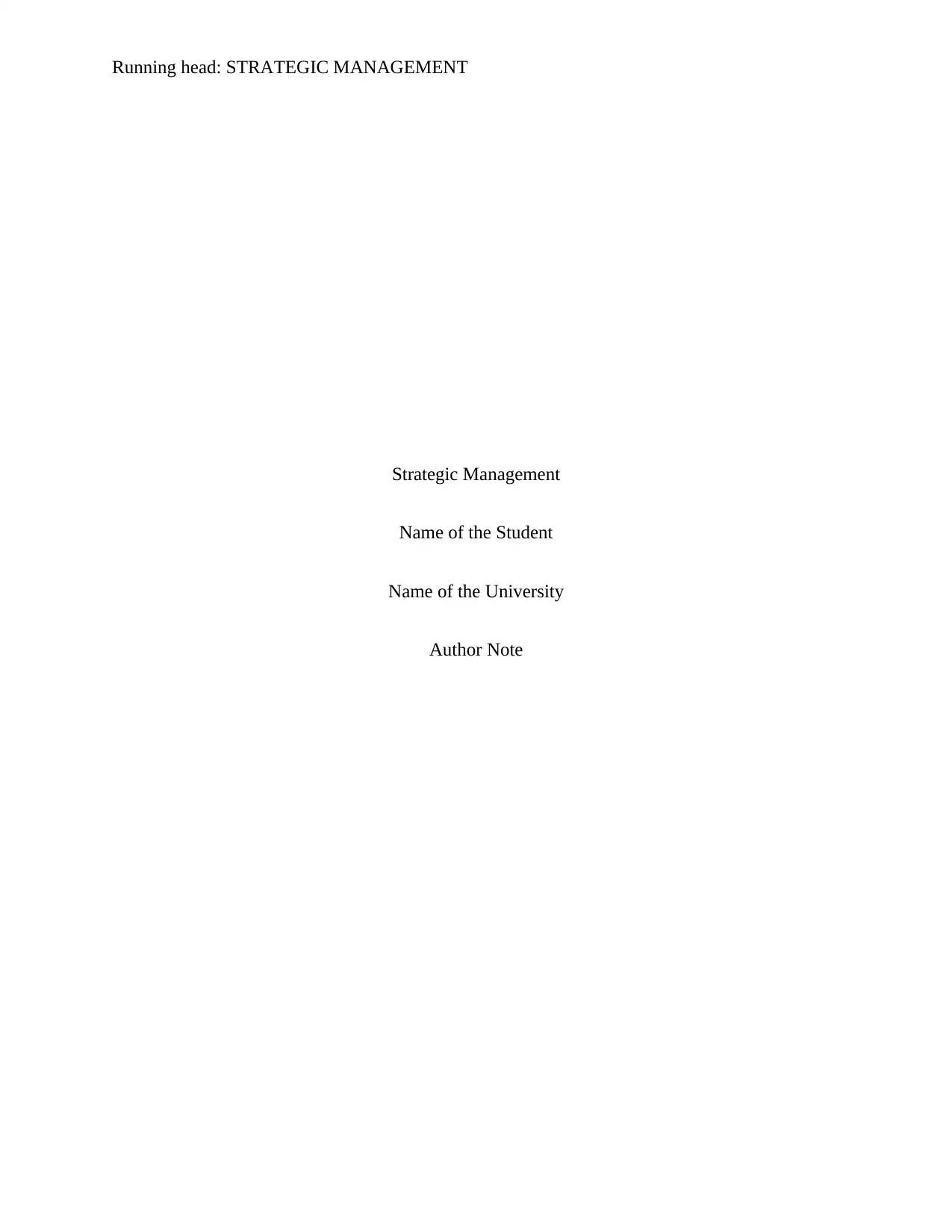
Running head: STRATEGIC MANAGEMENT
Strategic Management
Name of the Student
Name of the University
Author Note
Strategic Management
Name of the Student
Name of the University
Author Note
Paraphrase This Document
Need a fresh take? Get an instant paraphrase of this document with our AI Paraphraser
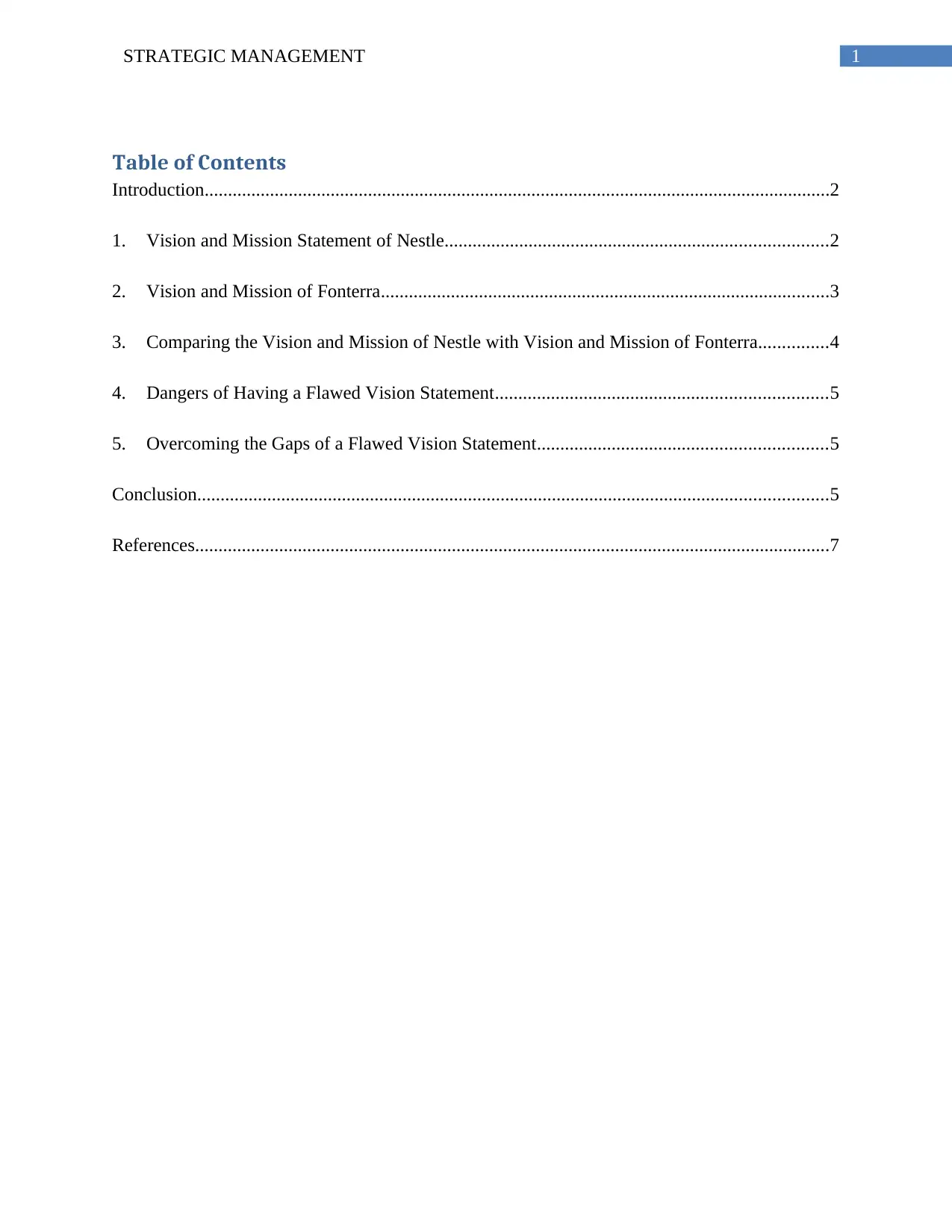
1STRATEGIC MANAGEMENT
Table of Contents
Introduction......................................................................................................................................2
1. Vision and Mission Statement of Nestle..................................................................................2
2. Vision and Mission of Fonterra................................................................................................3
3. Comparing the Vision and Mission of Nestle with Vision and Mission of Fonterra...............4
4. Dangers of Having a Flawed Vision Statement.......................................................................5
5. Overcoming the Gaps of a Flawed Vision Statement..............................................................5
Conclusion.......................................................................................................................................5
References........................................................................................................................................7
Table of Contents
Introduction......................................................................................................................................2
1. Vision and Mission Statement of Nestle..................................................................................2
2. Vision and Mission of Fonterra................................................................................................3
3. Comparing the Vision and Mission of Nestle with Vision and Mission of Fonterra...............4
4. Dangers of Having a Flawed Vision Statement.......................................................................5
5. Overcoming the Gaps of a Flawed Vision Statement..............................................................5
Conclusion.......................................................................................................................................5
References........................................................................................................................................7
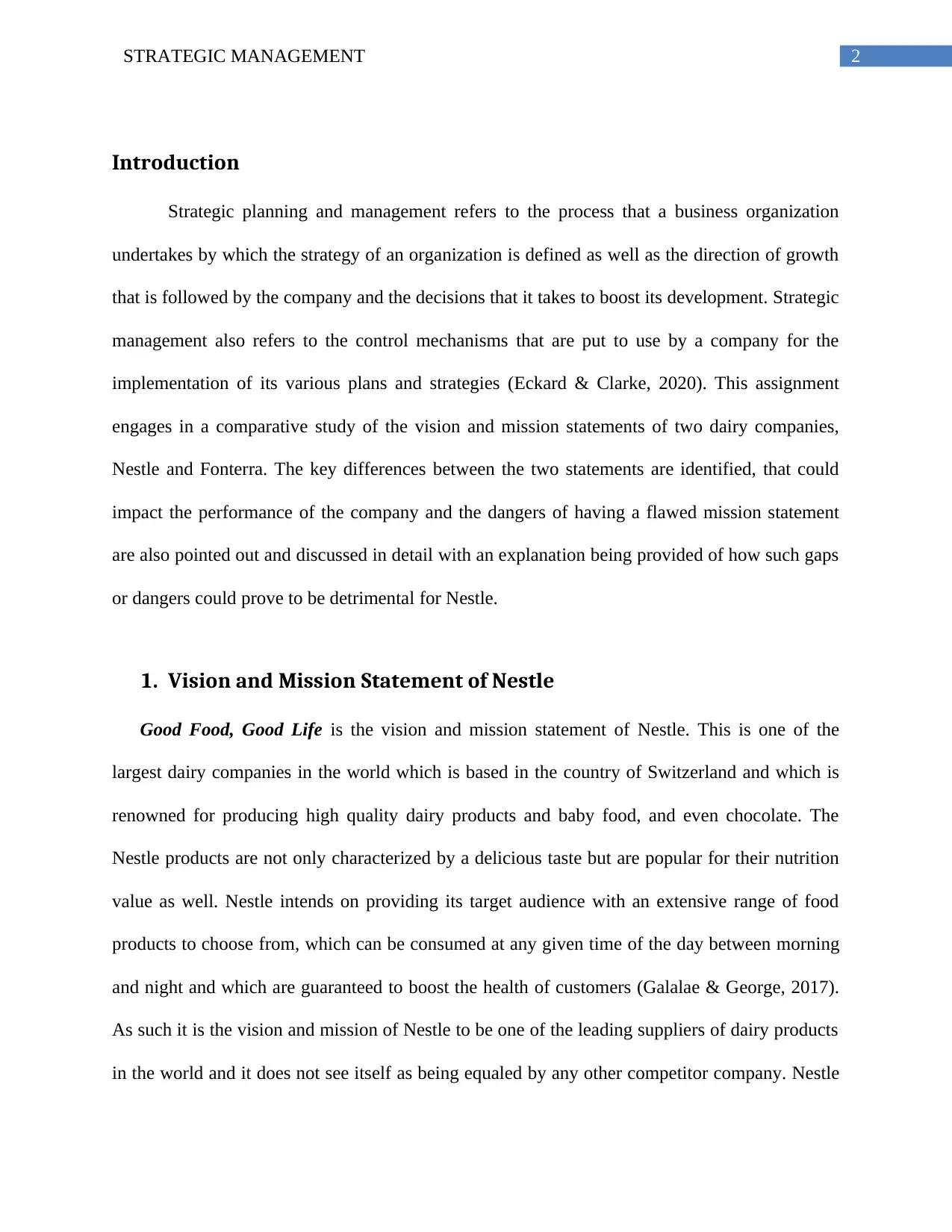
2STRATEGIC MANAGEMENT
Introduction
Strategic planning and management refers to the process that a business organization
undertakes by which the strategy of an organization is defined as well as the direction of growth
that is followed by the company and the decisions that it takes to boost its development. Strategic
management also refers to the control mechanisms that are put to use by a company for the
implementation of its various plans and strategies (Eckard & Clarke, 2020). This assignment
engages in a comparative study of the vision and mission statements of two dairy companies,
Nestle and Fonterra. The key differences between the two statements are identified, that could
impact the performance of the company and the dangers of having a flawed mission statement
are also pointed out and discussed in detail with an explanation being provided of how such gaps
or dangers could prove to be detrimental for Nestle.
1. Vision and Mission Statement of Nestle
Good Food, Good Life is the vision and mission statement of Nestle. This is one of the
largest dairy companies in the world which is based in the country of Switzerland and which is
renowned for producing high quality dairy products and baby food, and even chocolate. The
Nestle products are not only characterized by a delicious taste but are popular for their nutrition
value as well. Nestle intends on providing its target audience with an extensive range of food
products to choose from, which can be consumed at any given time of the day between morning
and night and which are guaranteed to boost the health of customers (Galalae & George, 2017).
As such it is the vision and mission of Nestle to be one of the leading suppliers of dairy products
in the world and it does not see itself as being equaled by any other competitor company. Nestle
Introduction
Strategic planning and management refers to the process that a business organization
undertakes by which the strategy of an organization is defined as well as the direction of growth
that is followed by the company and the decisions that it takes to boost its development. Strategic
management also refers to the control mechanisms that are put to use by a company for the
implementation of its various plans and strategies (Eckard & Clarke, 2020). This assignment
engages in a comparative study of the vision and mission statements of two dairy companies,
Nestle and Fonterra. The key differences between the two statements are identified, that could
impact the performance of the company and the dangers of having a flawed mission statement
are also pointed out and discussed in detail with an explanation being provided of how such gaps
or dangers could prove to be detrimental for Nestle.
1. Vision and Mission Statement of Nestle
Good Food, Good Life is the vision and mission statement of Nestle. This is one of the
largest dairy companies in the world which is based in the country of Switzerland and which is
renowned for producing high quality dairy products and baby food, and even chocolate. The
Nestle products are not only characterized by a delicious taste but are popular for their nutrition
value as well. Nestle intends on providing its target audience with an extensive range of food
products to choose from, which can be consumed at any given time of the day between morning
and night and which are guaranteed to boost the health of customers (Galalae & George, 2017).
As such it is the vision and mission of Nestle to be one of the leading suppliers of dairy products
in the world and it does not see itself as being equaled by any other competitor company. Nestle
⊘ This is a preview!⊘
Do you want full access?
Subscribe today to unlock all pages.

Trusted by 1+ million students worldwide
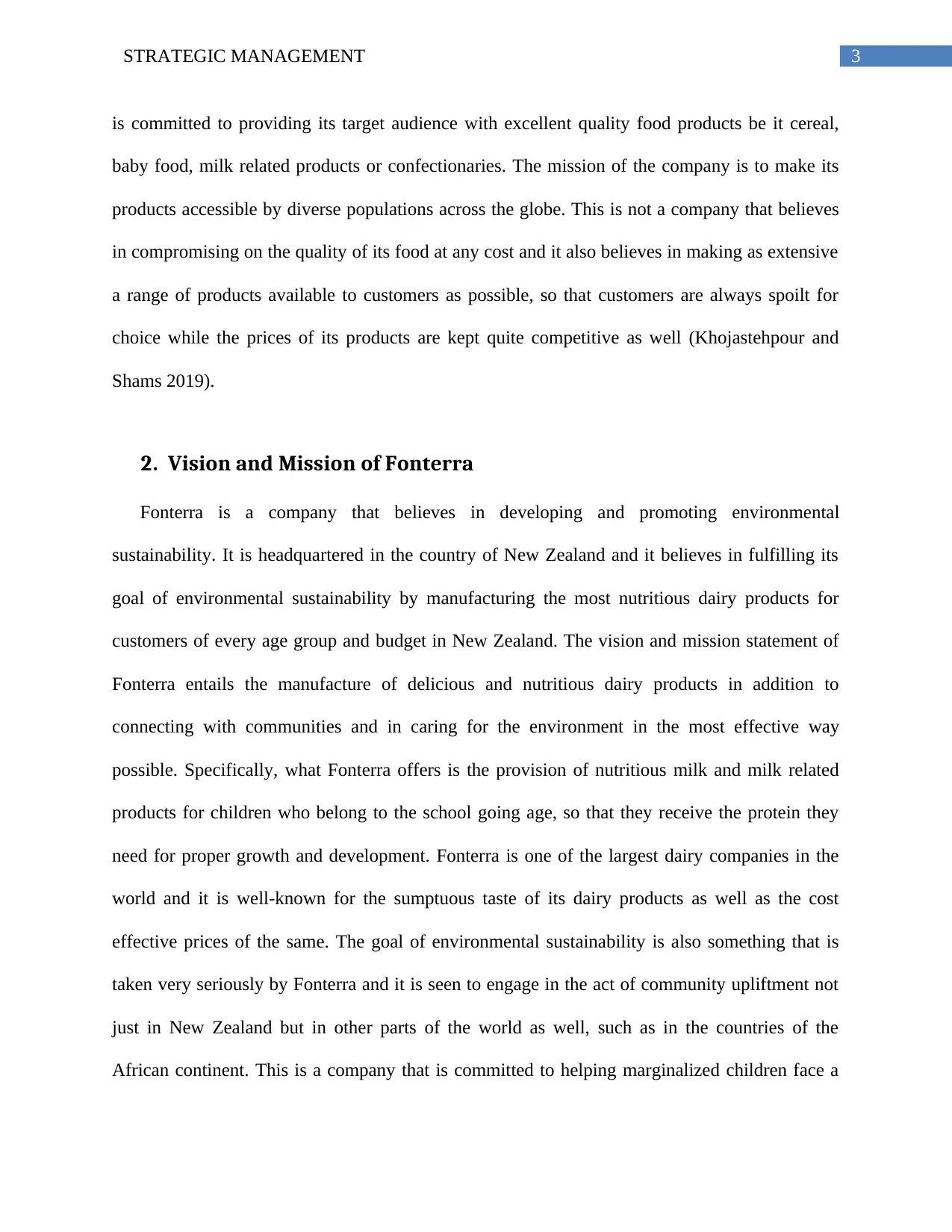
3STRATEGIC MANAGEMENT
is committed to providing its target audience with excellent quality food products be it cereal,
baby food, milk related products or confectionaries. The mission of the company is to make its
products accessible by diverse populations across the globe. This is not a company that believes
in compromising on the quality of its food at any cost and it also believes in making as extensive
a range of products available to customers as possible, so that customers are always spoilt for
choice while the prices of its products are kept quite competitive as well (Khojastehpour and
Shams 2019).
2. Vision and Mission of Fonterra
Fonterra is a company that believes in developing and promoting environmental
sustainability. It is headquartered in the country of New Zealand and it believes in fulfilling its
goal of environmental sustainability by manufacturing the most nutritious dairy products for
customers of every age group and budget in New Zealand. The vision and mission statement of
Fonterra entails the manufacture of delicious and nutritious dairy products in addition to
connecting with communities and in caring for the environment in the most effective way
possible. Specifically, what Fonterra offers is the provision of nutritious milk and milk related
products for children who belong to the school going age, so that they receive the protein they
need for proper growth and development. Fonterra is one of the largest dairy companies in the
world and it is well-known for the sumptuous taste of its dairy products as well as the cost
effective prices of the same. The goal of environmental sustainability is also something that is
taken very seriously by Fonterra and it is seen to engage in the act of community upliftment not
just in New Zealand but in other parts of the world as well, such as in the countries of the
African continent. This is a company that is committed to helping marginalized children face a
is committed to providing its target audience with excellent quality food products be it cereal,
baby food, milk related products or confectionaries. The mission of the company is to make its
products accessible by diverse populations across the globe. This is not a company that believes
in compromising on the quality of its food at any cost and it also believes in making as extensive
a range of products available to customers as possible, so that customers are always spoilt for
choice while the prices of its products are kept quite competitive as well (Khojastehpour and
Shams 2019).
2. Vision and Mission of Fonterra
Fonterra is a company that believes in developing and promoting environmental
sustainability. It is headquartered in the country of New Zealand and it believes in fulfilling its
goal of environmental sustainability by manufacturing the most nutritious dairy products for
customers of every age group and budget in New Zealand. The vision and mission statement of
Fonterra entails the manufacture of delicious and nutritious dairy products in addition to
connecting with communities and in caring for the environment in the most effective way
possible. Specifically, what Fonterra offers is the provision of nutritious milk and milk related
products for children who belong to the school going age, so that they receive the protein they
need for proper growth and development. Fonterra is one of the largest dairy companies in the
world and it is well-known for the sumptuous taste of its dairy products as well as the cost
effective prices of the same. The goal of environmental sustainability is also something that is
taken very seriously by Fonterra and it is seen to engage in the act of community upliftment not
just in New Zealand but in other parts of the world as well, such as in the countries of the
African continent. This is a company that is committed to helping marginalized children face a
Paraphrase This Document
Need a fresh take? Get an instant paraphrase of this document with our AI Paraphraser
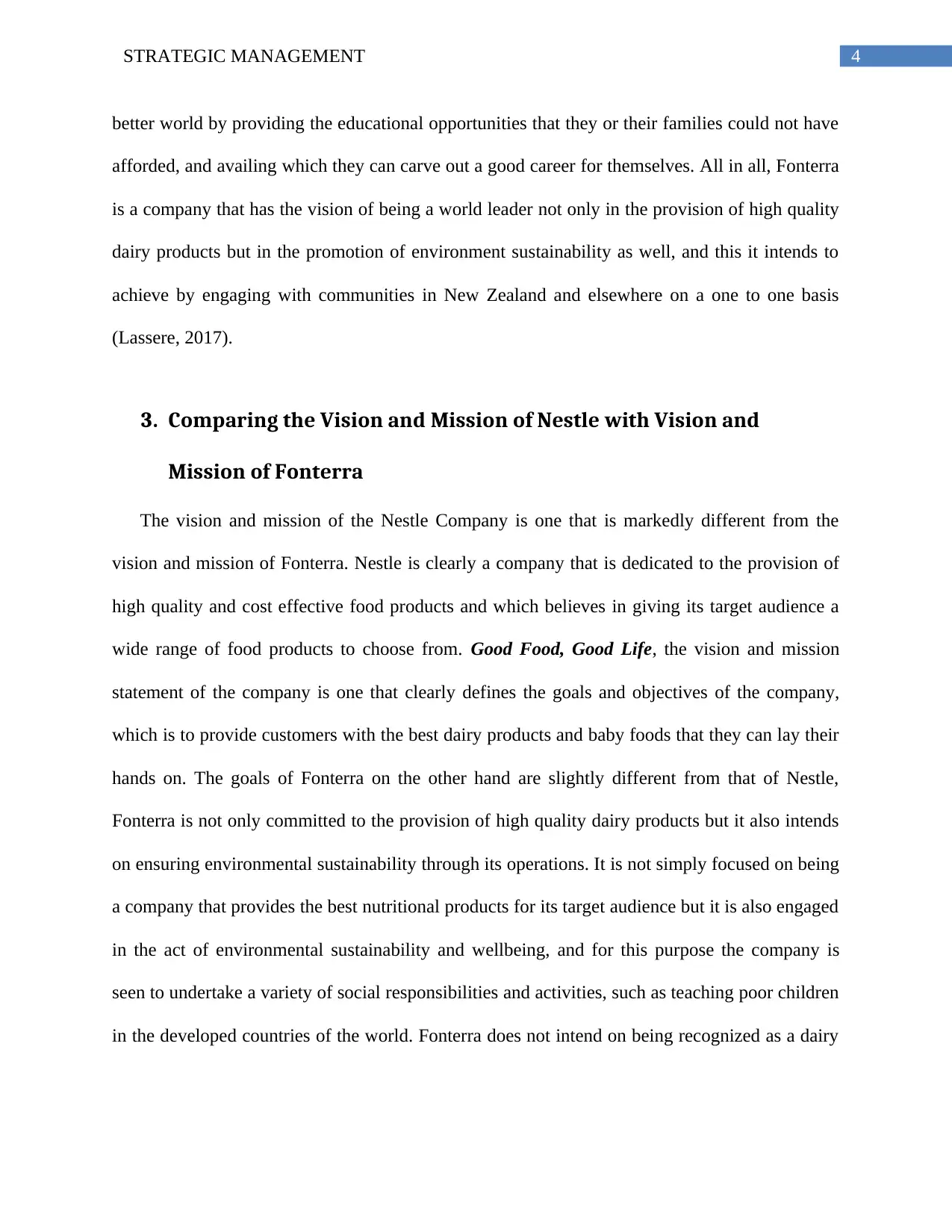
4STRATEGIC MANAGEMENT
better world by providing the educational opportunities that they or their families could not have
afforded, and availing which they can carve out a good career for themselves. All in all, Fonterra
is a company that has the vision of being a world leader not only in the provision of high quality
dairy products but in the promotion of environment sustainability as well, and this it intends to
achieve by engaging with communities in New Zealand and elsewhere on a one to one basis
(Lassere, 2017).
3. Comparing the Vision and Mission of Nestle with Vision and
Mission of Fonterra
The vision and mission of the Nestle Company is one that is markedly different from the
vision and mission of Fonterra. Nestle is clearly a company that is dedicated to the provision of
high quality and cost effective food products and which believes in giving its target audience a
wide range of food products to choose from. Good Food, Good Life, the vision and mission
statement of the company is one that clearly defines the goals and objectives of the company,
which is to provide customers with the best dairy products and baby foods that they can lay their
hands on. The goals of Fonterra on the other hand are slightly different from that of Nestle,
Fonterra is not only committed to the provision of high quality dairy products but it also intends
on ensuring environmental sustainability through its operations. It is not simply focused on being
a company that provides the best nutritional products for its target audience but it is also engaged
in the act of environmental sustainability and wellbeing, and for this purpose the company is
seen to undertake a variety of social responsibilities and activities, such as teaching poor children
in the developed countries of the world. Fonterra does not intend on being recognized as a dairy
better world by providing the educational opportunities that they or their families could not have
afforded, and availing which they can carve out a good career for themselves. All in all, Fonterra
is a company that has the vision of being a world leader not only in the provision of high quality
dairy products but in the promotion of environment sustainability as well, and this it intends to
achieve by engaging with communities in New Zealand and elsewhere on a one to one basis
(Lassere, 2017).
3. Comparing the Vision and Mission of Nestle with Vision and
Mission of Fonterra
The vision and mission of the Nestle Company is one that is markedly different from the
vision and mission of Fonterra. Nestle is clearly a company that is dedicated to the provision of
high quality and cost effective food products and which believes in giving its target audience a
wide range of food products to choose from. Good Food, Good Life, the vision and mission
statement of the company is one that clearly defines the goals and objectives of the company,
which is to provide customers with the best dairy products and baby foods that they can lay their
hands on. The goals of Fonterra on the other hand are slightly different from that of Nestle,
Fonterra is not only committed to the provision of high quality dairy products but it also intends
on ensuring environmental sustainability through its operations. It is not simply focused on being
a company that provides the best nutritional products for its target audience but it is also engaged
in the act of environmental sustainability and wellbeing, and for this purpose the company is
seen to undertake a variety of social responsibilities and activities, such as teaching poor children
in the developed countries of the world. Fonterra does not intend on being recognized as a dairy
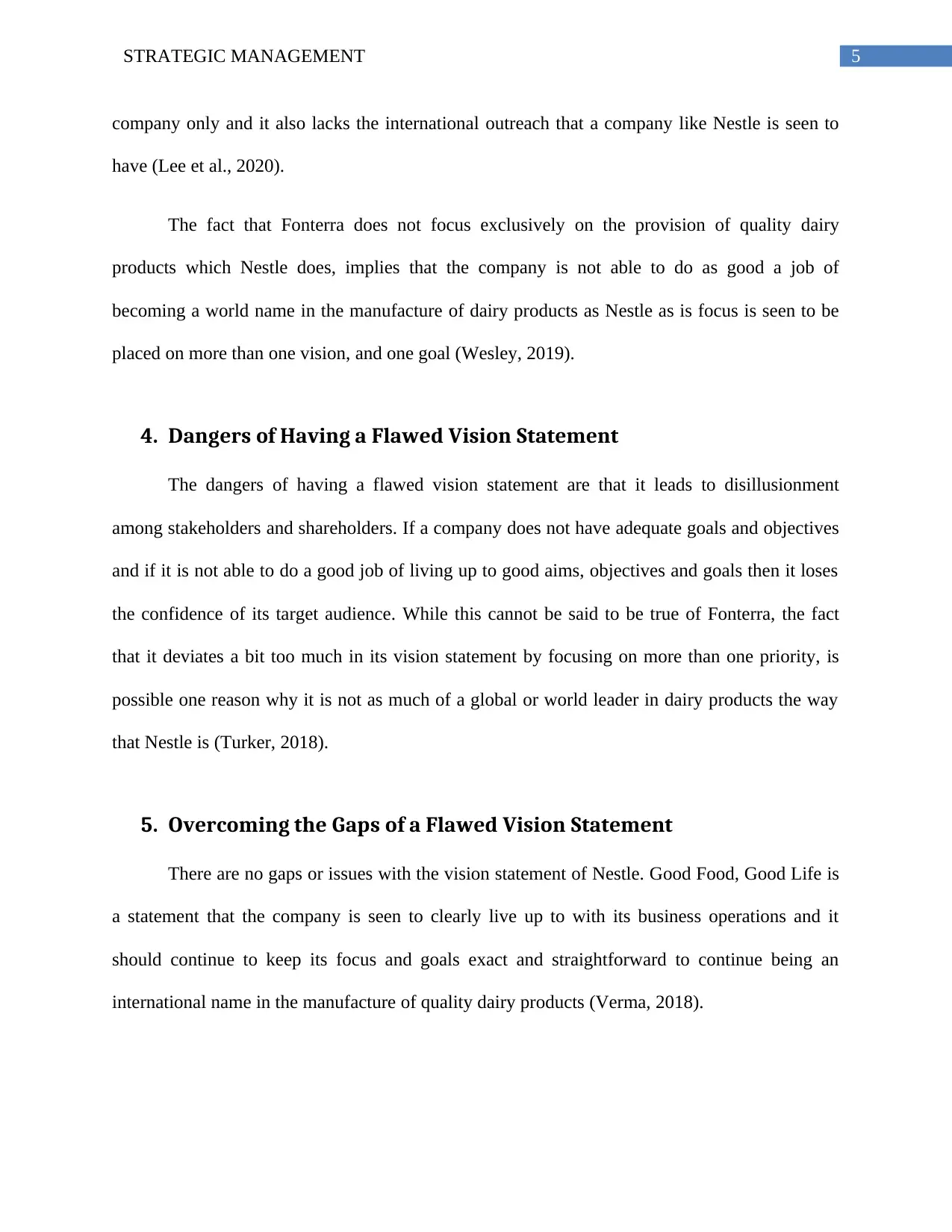
5STRATEGIC MANAGEMENT
company only and it also lacks the international outreach that a company like Nestle is seen to
have (Lee et al., 2020).
The fact that Fonterra does not focus exclusively on the provision of quality dairy
products which Nestle does, implies that the company is not able to do as good a job of
becoming a world name in the manufacture of dairy products as Nestle as is focus is seen to be
placed on more than one vision, and one goal (Wesley, 2019).
4. Dangers of Having a Flawed Vision Statement
The dangers of having a flawed vision statement are that it leads to disillusionment
among stakeholders and shareholders. If a company does not have adequate goals and objectives
and if it is not able to do a good job of living up to good aims, objectives and goals then it loses
the confidence of its target audience. While this cannot be said to be true of Fonterra, the fact
that it deviates a bit too much in its vision statement by focusing on more than one priority, is
possible one reason why it is not as much of a global or world leader in dairy products the way
that Nestle is (Turker, 2018).
5. Overcoming the Gaps of a Flawed Vision Statement
There are no gaps or issues with the vision statement of Nestle. Good Food, Good Life is
a statement that the company is seen to clearly live up to with its business operations and it
should continue to keep its focus and goals exact and straightforward to continue being an
international name in the manufacture of quality dairy products (Verma, 2018).
company only and it also lacks the international outreach that a company like Nestle is seen to
have (Lee et al., 2020).
The fact that Fonterra does not focus exclusively on the provision of quality dairy
products which Nestle does, implies that the company is not able to do as good a job of
becoming a world name in the manufacture of dairy products as Nestle as is focus is seen to be
placed on more than one vision, and one goal (Wesley, 2019).
4. Dangers of Having a Flawed Vision Statement
The dangers of having a flawed vision statement are that it leads to disillusionment
among stakeholders and shareholders. If a company does not have adequate goals and objectives
and if it is not able to do a good job of living up to good aims, objectives and goals then it loses
the confidence of its target audience. While this cannot be said to be true of Fonterra, the fact
that it deviates a bit too much in its vision statement by focusing on more than one priority, is
possible one reason why it is not as much of a global or world leader in dairy products the way
that Nestle is (Turker, 2018).
5. Overcoming the Gaps of a Flawed Vision Statement
There are no gaps or issues with the vision statement of Nestle. Good Food, Good Life is
a statement that the company is seen to clearly live up to with its business operations and it
should continue to keep its focus and goals exact and straightforward to continue being an
international name in the manufacture of quality dairy products (Verma, 2018).
⊘ This is a preview!⊘
Do you want full access?
Subscribe today to unlock all pages.

Trusted by 1+ million students worldwide
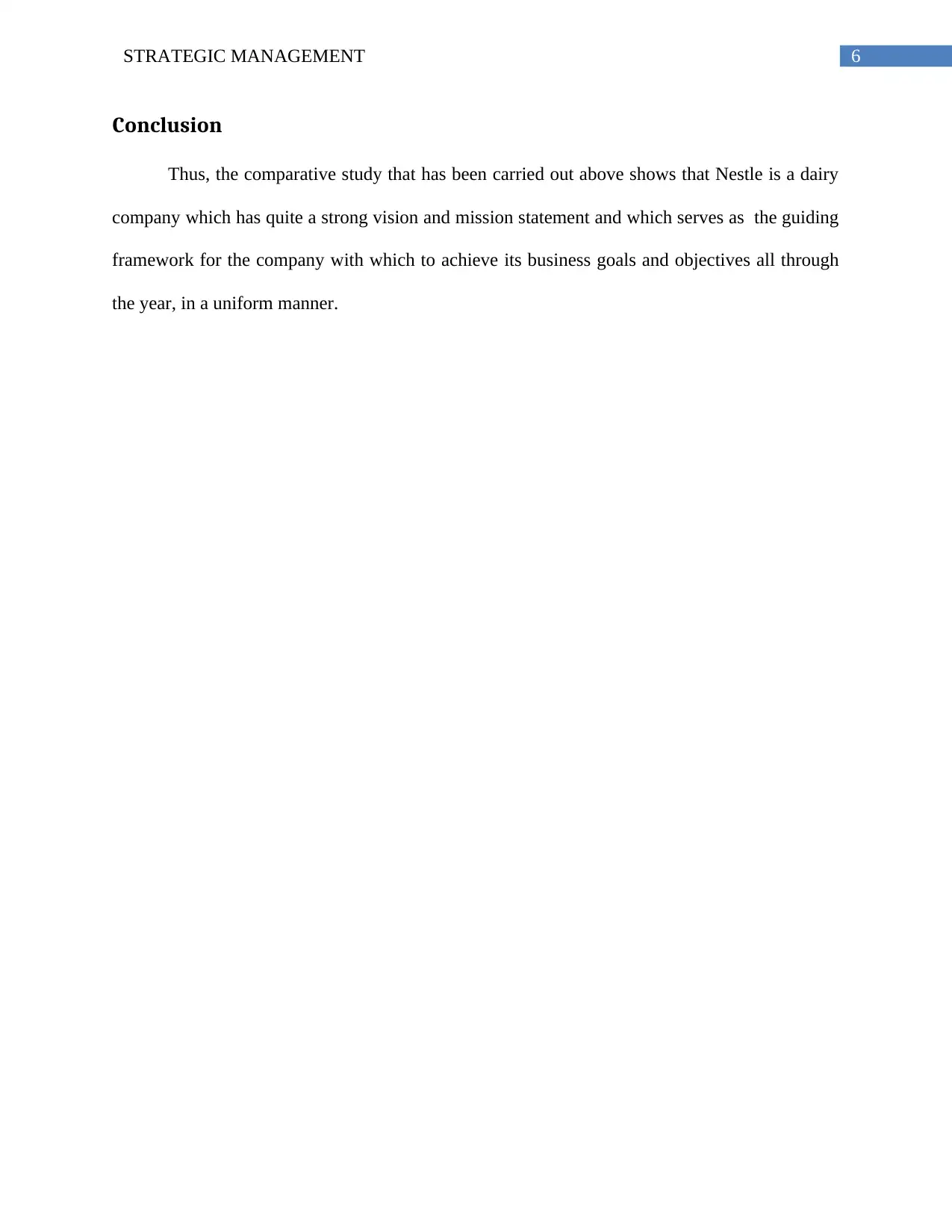
6STRATEGIC MANAGEMENT
Conclusion
Thus, the comparative study that has been carried out above shows that Nestle is a dairy
company which has quite a strong vision and mission statement and which serves as the guiding
framework for the company with which to achieve its business goals and objectives all through
the year, in a uniform manner.
Conclusion
Thus, the comparative study that has been carried out above shows that Nestle is a dairy
company which has quite a strong vision and mission statement and which serves as the guiding
framework for the company with which to achieve its business goals and objectives all through
the year, in a uniform manner.
Paraphrase This Document
Need a fresh take? Get an instant paraphrase of this document with our AI Paraphraser
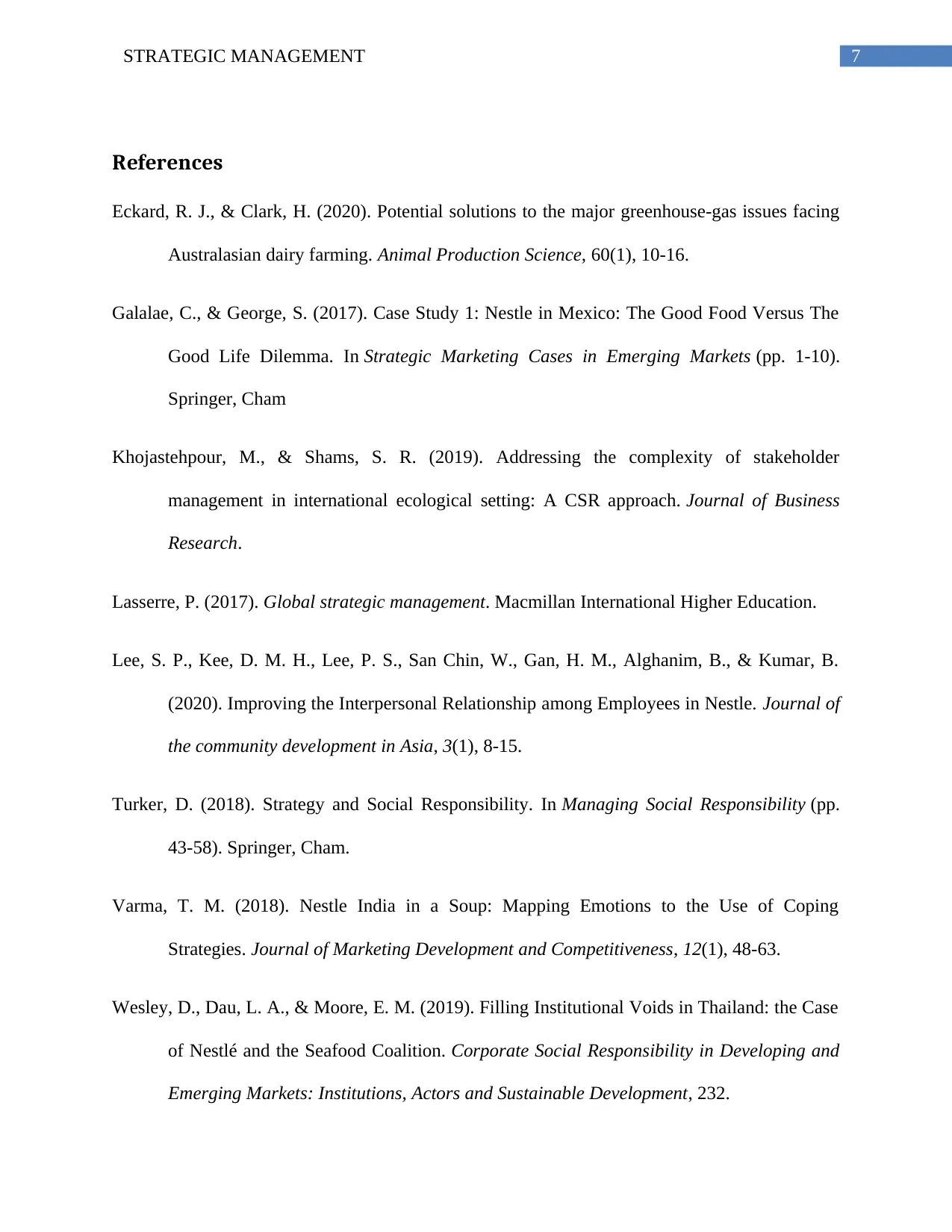
7STRATEGIC MANAGEMENT
References
Eckard, R. J., & Clark, H. (2020). Potential solutions to the major greenhouse-gas issues facing
Australasian dairy farming. Animal Production Science, 60(1), 10-16.
Galalae, C., & George, S. (2017). Case Study 1: Nestle in Mexico: The Good Food Versus The
Good Life Dilemma. In Strategic Marketing Cases in Emerging Markets (pp. 1-10).
Springer, Cham
Khojastehpour, M., & Shams, S. R. (2019). Addressing the complexity of stakeholder
management in international ecological setting: A CSR approach. Journal of Business
Research.
Lasserre, P. (2017). Global strategic management. Macmillan International Higher Education.
Lee, S. P., Kee, D. M. H., Lee, P. S., San Chin, W., Gan, H. M., Alghanim, B., & Kumar, B.
(2020). Improving the Interpersonal Relationship among Employees in Nestle. Journal of
the community development in Asia, 3(1), 8-15.
Turker, D. (2018). Strategy and Social Responsibility. In Managing Social Responsibility (pp.
43-58). Springer, Cham.
Varma, T. M. (2018). Nestle India in a Soup: Mapping Emotions to the Use of Coping
Strategies. Journal of Marketing Development and Competitiveness, 12(1), 48-63.
Wesley, D., Dau, L. A., & Moore, E. M. (2019). Filling Institutional Voids in Thailand: the Case
of Nestlé and the Seafood Coalition. Corporate Social Responsibility in Developing and
Emerging Markets: Institutions, Actors and Sustainable Development, 232.
References
Eckard, R. J., & Clark, H. (2020). Potential solutions to the major greenhouse-gas issues facing
Australasian dairy farming. Animal Production Science, 60(1), 10-16.
Galalae, C., & George, S. (2017). Case Study 1: Nestle in Mexico: The Good Food Versus The
Good Life Dilemma. In Strategic Marketing Cases in Emerging Markets (pp. 1-10).
Springer, Cham
Khojastehpour, M., & Shams, S. R. (2019). Addressing the complexity of stakeholder
management in international ecological setting: A CSR approach. Journal of Business
Research.
Lasserre, P. (2017). Global strategic management. Macmillan International Higher Education.
Lee, S. P., Kee, D. M. H., Lee, P. S., San Chin, W., Gan, H. M., Alghanim, B., & Kumar, B.
(2020). Improving the Interpersonal Relationship among Employees in Nestle. Journal of
the community development in Asia, 3(1), 8-15.
Turker, D. (2018). Strategy and Social Responsibility. In Managing Social Responsibility (pp.
43-58). Springer, Cham.
Varma, T. M. (2018). Nestle India in a Soup: Mapping Emotions to the Use of Coping
Strategies. Journal of Marketing Development and Competitiveness, 12(1), 48-63.
Wesley, D., Dau, L. A., & Moore, E. M. (2019). Filling Institutional Voids in Thailand: the Case
of Nestlé and the Seafood Coalition. Corporate Social Responsibility in Developing and
Emerging Markets: Institutions, Actors and Sustainable Development, 232.
1 out of 8
Related Documents
Your All-in-One AI-Powered Toolkit for Academic Success.
+13062052269
info@desklib.com
Available 24*7 on WhatsApp / Email
![[object Object]](/_next/static/media/star-bottom.7253800d.svg)
Unlock your academic potential
Copyright © 2020–2025 A2Z Services. All Rights Reserved. Developed and managed by ZUCOL.





